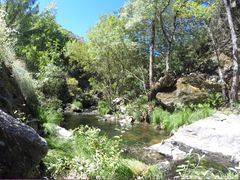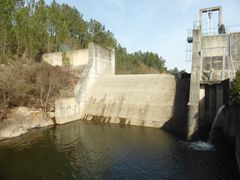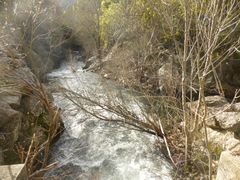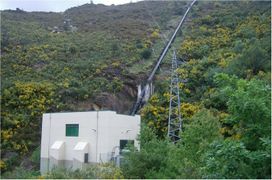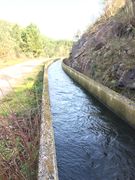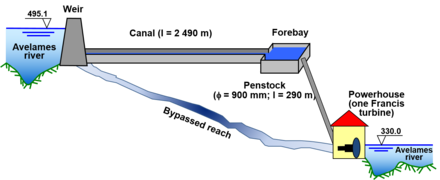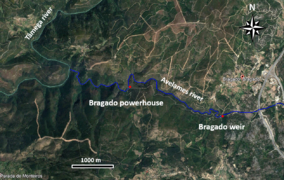Difference between revisions of "Bragado test case"
Bendikhansen (talk | contribs) |
|||
| Line 65: | Line 65: | ||
The hydropeaking assessment indicated a combined score of 14 for the effect factors, corresponding to a large impact, and a combined score of 5.5 for the vulnerability factors, corresponding to a low impact. The final assessment, combining both the effect and vulnerability factors, resulted in an overall moderate (yellow) hydropeaking impact of the Bragado HPP. | The hydropeaking assessment indicated a combined score of 14 for the effect factors, corresponding to a large impact, and a combined score of 5.5 for the vulnerability factors, corresponding to a low impact. The final assessment, combining both the effect and vulnerability factors, resulted in an overall moderate (yellow) hydropeaking impact of the Bragado HPP. | ||
| + | |||
| + | =Gallery= | ||
| + | <gallery mode=packed> | ||
| + | bragado_low_flow.jpg|Avelames River view, downstream of the Bragado powerplant, in a low flow situation | ||
| + | bragado_fish_survey|Tagged fish survey upstream of the Bragado weir | ||
| + | </gallery> | ||
=Gallery= | =Gallery= | ||
Revision as of 09:53, 29 June 2020
| Fact box: Bragado | |
|---|---|
| Country | Portugal |
| River | Avelames |
| Operator | HIDROERG |
| Capacity | 3.1 MW |
| Head | 155 m |
| Inter-annual discharge | 1.4 m3/s |
| Turbine(s) | 1 Francis turbine with horizontal shaft |
| Detailed report | Click for pdf |
| Relevant solutions | Applied in test case? |
|---|---|
| Fish-friendly turbines | Yes |
| Mitigating rapid, short-term variations in flow (hydro-peaking operations) | Yes |
| Mitigating reduced annual flow and low flow measures | Yes |
| Mitigating reduced flood peaks, magnitudes, and frequency | - |
| Operational measures (turbine operations, spillway passage) | - |
| Vertical slot fishways | - |
| Relevant MTDs | Applied in test case? |
| CASiMiR | - |
| COSH-tool | Yes |
| Current meter | Yes |
| Differential pressure sensor base artificial lateral line probe, iRon | Yes |
| Fish Protection System (induced drift application) | - |
| FLOW-3D | Yes |
| HEC-RAS | Yes |
| Hydropeaking indicator | Yes |
| Hydropeaking tool | Yes |
| OpenFOAM | - |
| Radio frequency identification with passive integrated transponder (PIT tagging) | Yes |
| Radio telemetry | - |
| River2D | - |
| Shelter measurements | Yes |
| TELEMAC | - |
Contents
Introduction
The Bragado Hydropower plant (HPP) is located in the North of Portugal, on the Avelames river, which is a tributary of the Tâmega river (Douro river basin).
The Avelames river is characterized by a strong seasonal variation in flow, with the highest discharge peaks occurring during the wet semester (October-March). Inter-annual variation in precipitation and, consequently, in runoff, is also large, as it is typical of a river with a Mediterranean flow regime. Mean long term annual discharge at Bragado weir amounts to 1.4 m3/s. The catchment area of the Avelames river at the section of Bragado weir is 78.8 km2. There are no other HPPs in the same river.
The water body at the HPP Bragado is classified as a natural water body with Good Ecological Status.
About the hydropower plant
Bragado is a run-of-river HPP with partial daily flow regulation. It has an installed capacity of 3.1 MW and a mean annual electricity production of 9.0 GWh. The small reservoir created by the weir has a useful storage capacity of 25000 m3 (total capacity of 34000 m3), located between the full reservoir level, FRL=495.10 m, and minimum drawdown level, MDDL=492.80 m. The weir was designed for the 100-year peak flood discharge of 230 m3/s.
The powerhouse of Bragado was designed for a maximum turbined discharge (or design discharge) of 2.2 m3/s and a net head of 155.2 m and it is equipped with one Francis turbine with horizontal shaft. The water permit of Bragado was issued in 1996, the construction of the scheme started in August 1997 and the first connection to the national electricity grid took place in December 1998.
Layout
The Bragado HPP is placed in a rural zone that is dominated by shrub and forested areas. The small parish of Bragado (544 inhabitants in 2011) is the nearest village (approx. 700 m from the weir).
The Bragado HPP includes a small weir equipped with a submerged water intake. The weir creates a reservoir with a useful capacity and an area at the FRL of 25000 m3 and 5600 m2, respectively. Downstream of the water intake is the conveyance system which includes an open canal (2490 m long), a fore bay, a penstock (f=900 mm and 290 m long) and a powerhouse (installed capacity of 3.1 MW). The bypassed reach of the Avelames River, comprehended between the weir and the tailrace of Bragado, is 3.7 km long.
The minimum instream flow/ecological flow release by the weir is of 0.064 m3/s. Due to the low river connectivity downstream of Bragado HPP no fish pass was built in the weir.
The Operator: Hidroerg
The HPP is operated by Hidroerg – Projectos Energéticos, Lda, incorporated in 1989 and headquartered in Lisbon. The Company's purpose is to build, manage and operate power facilities designed for the production of electricity from renewable energy sources. The company has a strong focus on hydropower, being skilled in the identification of sites, conception and planning of systems and schemes, feasibility and impact assessment, coordination of the civil construction works and equipment installation, and in management of energy production facilities, in a framework of sustainable development and of generation of both national and entrepreneurial economic value. Read more.
Pressures on the water body's ecosystem
The river quality is influenced by discharges from wastewater treatment plants, as well as from agriculture and animal husbandry. The river hydromorphology is influenced by the HPP operation. Nevertheless, according to the Douro River Basin Management Plan, the natural water body PT03DOU0211 where the HPP is located is in a Good Ecological State.
Test case topics
Fish population
The fish community of the Avelames River is dominated by small sized native cyprinids, such as Iberian chub (Squalius carolitertii), Iberian nase (Pseudochondrostomo duriense), calandino (Squalius alburnoides), similarly to other rivers in northern Portugal. Further downstream, close to the confluence with Tâmega River, which is one of the main Portuguese watersheds, other species can be found, including the larger sized Iberian barbel (Luciobarbus bocagei). Further upstream, some brown trout (Salmo trutta) can be found.
Migration devices
The Bragado weir does not have a fish pass for either upstream or downstream fish migration. Such device was considered unnecessary by the Portuguese authorities since the HPP is placed in a reach of the Avelames River with reduced natural longitudinal connectivity, due to the occurrence of natural falls. Furthermore, migratory fish species requiring long distance movements to reproduce do not occur in this river.
To reduce fish entrance in the hydraulic circuit, the submerged water intake is protected by a movable vertical trash rack with 1.5 x 2.4 m2 (clear space between bars of 5 cm).
Hydropeaking
The rapid variation of river discharges at the powerhouse tailrace during intermittent electricity production (hydropeaking effect) can produce negative effects on the fish specimens, namely because such intermittent operation occurs during periods where the expected natural discharge would be very small (late Spring and Summer). Hydropeaking can promote the occurrence of depauperated fish assemblages in terms of the species and size-classes. However, its consequences in Iberian streams, where fish assemblages are composed mainly by endemic species, are still relatively unknown.
E-flow
The minimum instream flow/ecological flow to be released downstream Bragado weir was fixed as a percentage of the mean annual flow (approx. 5%), which was a common procedure by the time the scheme was licensed (1996). The HPP is obliged to release a minimum instream flow (e-flow) of 64 l/s, if such flow is compatible with the natural inflow. In periods with natural discharges smaller than 64 l/s, the whole inflow is automatically released downstream and the powerhouse does not operate.
The efficiency of the instream minimum flow, regarding the environmental objectives set in the Water Framework Directive, has never been assessed; however, the water body were the HPP is located presents a Good Ecological State.
Research objectives and tasks
Information about the effects of hydropeaking in Iberian small streams is relatively scarce. Therefore, the effects of hydropeaking in small Iberian streams are investigated at Bragado. For this, river discharges, habitat and fish populations will be studied at two contrasting river reaches (i.e. a natural reach unaffected by hydropeaking and a river reach affected by hydropeaking). The fish behavior at the two sites will be analyzed and assessed. Based on the results, appropriate solutions for reducing/mitigating such effects will be identified.
Research tasks
At the Bragado HPP the following (scientific) research tasks are planned:
- Analysis of river discharges, habitat and fish populations in two river reaches:
- upstream the Bragado reservoir (natural reach, i.e. unaffected by the hydropeaking) and
- downstream the tailrace of the powerhouse (reach affected by hydropeaking)
- Assessment of the hydropeaking effects by comparing the river regime, the habitat and the fish populations/assemblages between the two sites.
- The previous comparison will include a comparative assessment of fish behaviour (movement and habitat use)
- Evaluation, through modelling, of SMDT available to mitigate the effects of hydropeaking
- Possible field implementation and assessment of selected SMDT
Results
Fish assemblage community of the Avelames River is dominated by small sized native cyprinids, as it is typical of similar rivers in northern Portugal. Iberian chub (Squalius carolitertii) (mean total length (TL) 9.7 ± 1.8 cm; mean total weight (TW) 12.6 ± 9.6 g), calandino (Squalius alburnoides) (TL 9.9 ± 1.9 cm; TW 7.5 ± 1.0 g), and Iberian nase (Pseudochondrostoma duriense) (TL 9.9 ± 1.9 cm; TW 10.4 ± 7.0 g) were tagged downstream Bragado HPP with passive integrated transponders to assess their habitat use and movement behaviour in response to hydropeaking. The total detection rate was 59%. Fish were distributed along the river reach with high density upstream the water release. P. duriense tend to prefer higher depths and higher velocities when compared to S. carolitertii. Only the . duriense was found immediately downstream the water release in the most disturbed area. Furthermore, the preliminary results obtained with the Lateral Line Probe indicate that fish presence was associated with lower pressure fluctuations and asymmetry. The highest fluctuations and asymmetry were observed in areas where fish were not detected, whereas both presences and absences occurred in the whole range of mean front pressure.
Based on these fish habitat use results, a lateral refuge (40 cm high; 40 cm wide and 50 cm long) was installed in the left river bank c. 40 m downstream the water release, where a high density of fish was found to occur. A multispectral stereo underwater camera was fixed inside the refuge to monitor refuge use under base and peak flow. Preliminary results indicate fish using the refuge c. 10 min after the turbines starting. Larger adults tend to appear after the turbine discharge reached 1 m3/s or more.
The hydropeaking assessment indicated a combined score of 14 for the effect factors, corresponding to a large impact, and a combined score of 5.5 for the vulnerability factors, corresponding to a low impact. The final assessment, combining both the effect and vulnerability factors, resulted in an overall moderate (yellow) hydropeaking impact of the Bragado HPP.
Gallery
- Bragado fish survey
Tagged fish survey upstream of the Bragado weir
